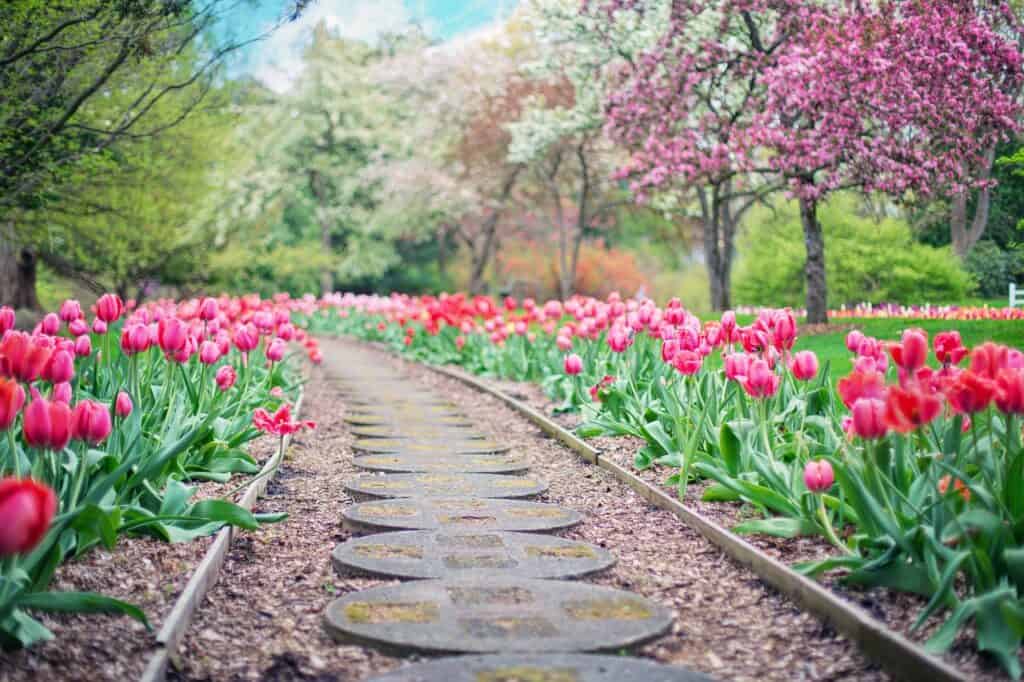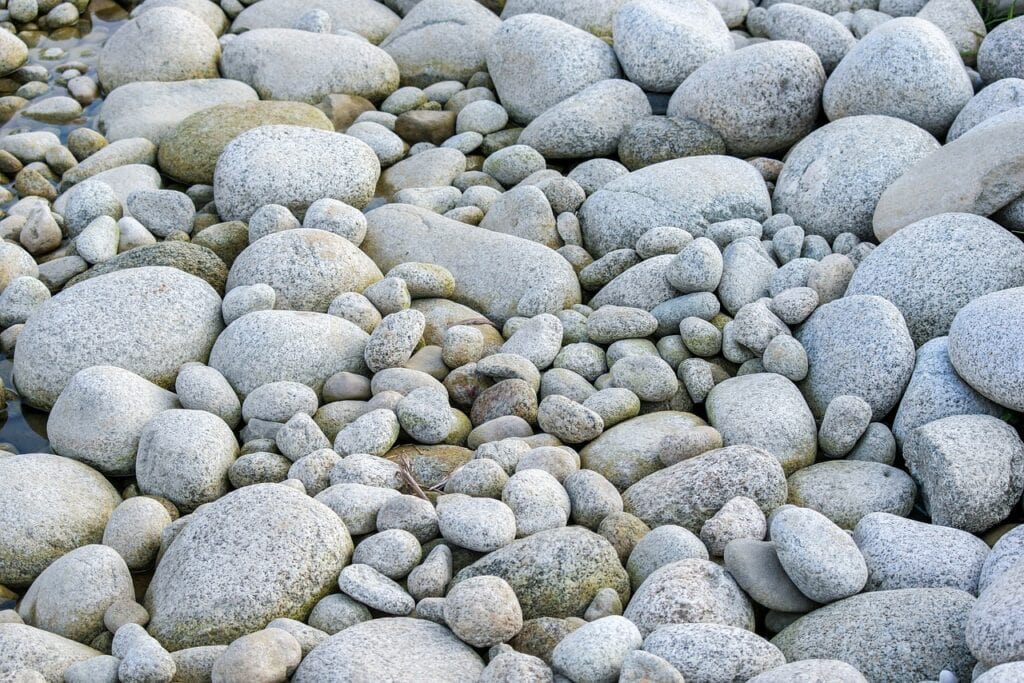
Looking to add some texture and creative flare to your front or back garden? Decorative aggregates are functional and affordable and come in various colours, sizes, and textures; they might just be the solution for your landscaping renovation.
At Oz Landscape Supplies, we offer a range of natural aggregates that can be used for functional and aesthetic purposes, from reducing water wastage and weeds to adding a splash of extra colour and character to your garden.
We have three new luxurious aggregates: Lava Stone, Mottled Black, and Snow White.

To celebrate our new decorative pebbles and aggregates, we’ve compiled a list of creative ways you can utilise them (and our other aggregates) to upscale your landscaping, from charming garden pathways to functional weed control and smart drainage solutions for backyards.
Create a high-aesthetic garden pathway

Creating a garden pathway using decorative aggregates can be a wonderful way to enhance the aesthetic appeal of your outdoor space.
We’ve listed pathway landscaping ideas below, but remember to consider the overall design and theme of your garden when choosing aggregates for your pathway. This will ensure a harmonious look that enhances the beauty of your outdoor space.
| Simple Gravel Pathway: Choose a gravel colour that complements the surrounding plants and flowers, lay a weed barrier fabric, and spread the gravel over it. | Stepping Stones with Aggregates: Place large stepping stones and fill the gaps with decorative aggregates. This creates a “stepped” pathway effect. | Mosaic Patterns: Use coloured aggregates to create mosaic patterns on your pathway. This can be as simple as a border of contrasting colours or intricate designs. |
| Aggregate Borders: If you have a concrete or brick pathway, you can use decorative aggregates as a border. This adds a touch of colour and texture to an otherwise plain path. | Mixed Materials: Combine aggregates with other materials like wood, bricks, or tiles. For example, you can have wooden planks interspersed with sections of decorative aggregates. | Aggregate and Grass Combo: Lay aggregates so that there are gaps for grass to grow. This creates a “checkerboard” effect and is especially suitable for gardens with a more natural look. |
| Edging with Plants: Use decorative aggregates for the pathway and edge it with low-growing plants or ground covers. This softens the look of the pathway and integrates it seamlessly into the garden. | Rainwater Path: Design your pathway so that it also aids in rainwater harvesting or directs rainwater to plants. The aggregates will allow water to seep through and can prevent waterlogging. | Contrasting Textures: Use aggregates of different sizes or textures for added visual interest. For instance, mix fine sand with larger pebbles. |
Improve drainage in your backyard

As well as adding visual interest to your garden, decorative aggregates can also significantly improve drainage in your garden. Aggregates, by their very nature, are porous; when used in garden beds or pathways, they allow water to flow between the individual stones or pebbles, facilitating rapid drainage and preventing water from pooling on the surface.
Here are some other ways decorative aggregate can improve drainage in your backyard!
| Prevention of Soil Compaction: Over time, soil, especially clay-heavy soil, can become compacted. This compaction can hinder water absorption and lead to poor drainage. By incorporating decorative aggregates into or on top of the soil, you can prevent or reduce this compaction, allowing water to flow more freely. | Erosion Control: In areas prone to erosion, especially on slopes or inclines, decorative aggregates can act as a protective barrier. They can prevent the washing away of topsoil during heavy rains, ensuring that the soil remains in place and that water drains in a controlled manner. | Mulching Alternative: While mulches decompose over time and retain moisture, aggregates do not decompose and can help ensure that excess water drains away from plant roots, preventing root rot. |
| Base Layer for Pathways and Patios: When constructing pathways, patios, or other garden features, a base layer of coarse aggregates can be used to improve drainage. This layer ensures that water drains away from the surface and prevents the formation of puddles. | Raised Garden Beds: Decorative aggregates can be used at the base of raised garden beds to enhance drainage. This benefits plants that prefer well-draining soil, like succulents or certain vegetables. | Decorative Drainage Channels: Create decorative drainage channels or swales filled with aggregates. These channels can guide water through the garden, preventing flooding in certain areas and directing water to where needed or to a proper runoff area. |
| Around Foundations and Structures: Using decorative aggregates around the foundations of garden structures or your home can prevent water from pooling and ensure it’s directed away from the foundation, reducing the risk of water damage or seepage. | Aesthetic Appeal: Beyond the functional benefits, decorative aggregates can add visual appeal to drainage solutions. For instance, a dry river bed made of decorative stones can serve as a drainage channel and a garden feature. | Reduction of Waterlogged Areas: In areas of the garden that tend to become waterlogged, a generous layer of decorative aggregates can help to absorb and disperse excess water, reducing the risk of stagnant water and associated problems like mosquito breeding. |
Resurface your driveway

Aggregates are a popular and affordable choice for resurfacing or setting up driveways. The most common type of aggregate is gravel, ranging from pea-sized pieces to about an inch in diameter, or crushed stone for a more textured, stable surface than rounded gravel.
Utilising aggregates is less expensive and labour-intensive than pouring a concrete driveway and can usually be completed in a day or two (depending on the driveway’s size). However, it’s important to note that aggregates should be laid on a hard surface with suitable edging and be compacted in several layers for best results.
Landscaping a pond

Using decorative aggregates in a fish pond adds aesthetic appeal like colour, texture and visual interest while also mimicking the natural habitats of many fish species (ultimately making them feel more at home). Plus, aggregates can provide surface area for beneficial bacteria to colonise, helping to break down waste and maintain water quality.
However, it’s crucial to choose the right aggregates to ensure your fish stay happy and healthy in their new environment, i.e. untreated, 100% natural aggregates with smooth edges.
Here are some other elements to keep in mind while landscaping a pond.
| Choose Natural, Untreated Aggregates: Ensure the aggregates are free from chemicals, dyes, or other substances that could harm fish or disrupt the pond’s ecosystem. | Rinse Thoroughly: Before introducing any aggregate into the pond, rinse it thoroughly with clean water to remove dust, dirt, and loose particles. | Avoid Sharp Edges: Choose aggregates with smooth surfaces to prevent fish from getting injured. |
| Consider Pond Maintenance: While aggregates can enhance the pond’s beauty, they can also make cleaning more challenging. Consider how you’ll clean the pond and remove algae accumulating over time. | Depth Consideration: If you have digging fish species like koi, consider the depth where you place the aggregates. Koi, for instance, might displace or dig into the substrate. | Planting Around a Pond: Use aggregates to anchor aquatic plants, creating a more natural and vibrant pond environment. |
| Monitor Water Quality: Introducing aggregates can initially affect the water’s pH. Monitor the water parameters and ensure they remain within safe limits for your fish. |
Put together a drought-tolerant garden

Australia is well-known for long-lasting drought periods — in 2018, 100% of New South Wales was declared drought, and September 2023 was the driest month on record since the 1990s! With this in mind, water conservation is always paramount, and decorative aggregates are a sustainable way to conserve water and reduce maintenance in your yard.
Here are just a few ways aggregates can make a difference.
| Reduces Evaporation: When used as a mulch around plants, and decorative aggregates act as a barrier, reducing the rate of water evaporation from the soil. | Maintains Cooler Soil: Light-coloured aggregates reflect sunlight, helping to keep the soil cooler. Cooler soil can reduce water loss through evaporation. | Limits Weed Growth: Weeds compete with your plants for water. A layer of decorative aggregates can suppress weed growth, ensuring that less water is wasted on unwanted plants. |
| Reduces Need for Herbicides: With fewer weeds, there’s less need for watering associated with herbicide application. | Protects Soil: In areas prone to runoff, decorative aggregates can help hold the soil in place, preventing erosion and the loss of valuable topsoil. | Promotes Water Percolation: Aggregates can guide water flow, encouraging it to percolate into the ground rather than running off. This can help recharge groundwater and reduce the need for supplemental watering. |
| Reduces Turf Areas: Lawns require a significant amount of water. By replacing some or all of your lawn areas with decorative aggregates, you can drastically reduce water usage. | Creates Drought-Tolerant Zones: Design specific zones in your garden with drought-tolerant plants (like succulents or native plants) and decorative aggregates. These zones will require minimal to no additional watering. | Long-Lasting: Unlike organic mulches, decorative aggregates don’t decompose, so they don’t need to be replaced as frequently. This reduces the water needed for the establishment of new mulch. |
| Stability: Aggregates don’t shift easily, ensuring that garden areas remain protected for longer periods, reducing the frequency of maintenance and watering. | Guides Water Flow: Decorative aggregates can create channels or basins that guide water directly to plant roots, reducing water waste. | Prevents Water Logging: Aggregates ensure that excess water doesn’t remain stagnant around plant roots, which can lead to root rot. This means you don’t have to compensate by overwatering. |
Weed control

If weeds are a common problem in your garden, decorative aggregates are a clever, beautiful and affordable way to combat them. When laid thickly, aggregates create a heavy, physical barrier that prevents weeds from growing through the soil. Plus, aggregates can help reduce soil erosion by protecting the soil from direct rainfall and runoff, helping to keep weeds in control.
Other benefits include:
- Blocking Sunlight: Weeds, like all plants, need sunlight to grow. A layer of aggregates can block sunlight, preventing weeds from germinating.
- Stability: Decorative aggregates don’t shift easily. Once in place, they’ll provide consistent weed suppression, protection from the sun, and reduced soil erosion.
It’s important to note that while aggregates can significantly reduce weed growth, it doesn’t eliminate weeds entirely. Some persistent weeds can grow through the gaps between aggregates, so we recommend using a weed control fabric underneath the aggregates to improve their effectiveness.
Stock up on decorative aggregates for your yard at Oz Landscape Supplies!
Landscaping with gravel and decorative aggregates is not only a practical choice for weed control and soil preservation but also a creative way to elevate the aesthetic appeal of your front or back garden. These natural materials blend functionality and design, providing long-lasting durability and a contemporary flair.
No matter the theme or design of your outdoor space, you’ll find the perfect decorative aggregates at Oz Landscape Supplies! Drop into our locations in Cameron Park or Toronto to discuss landscape design with our team and shop decorative aggregates today.
NOTE: Our Bennetts Green location is available by appointment for trade sales and pickups.
